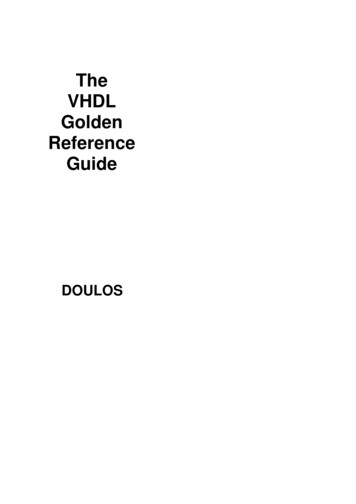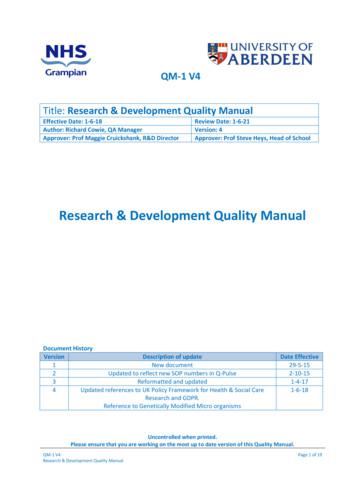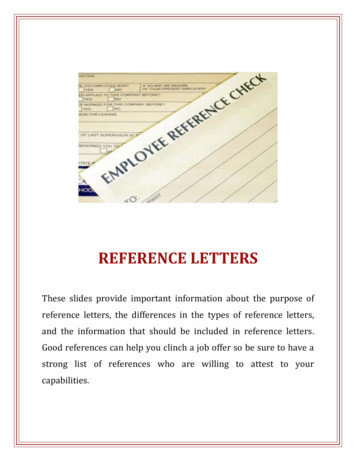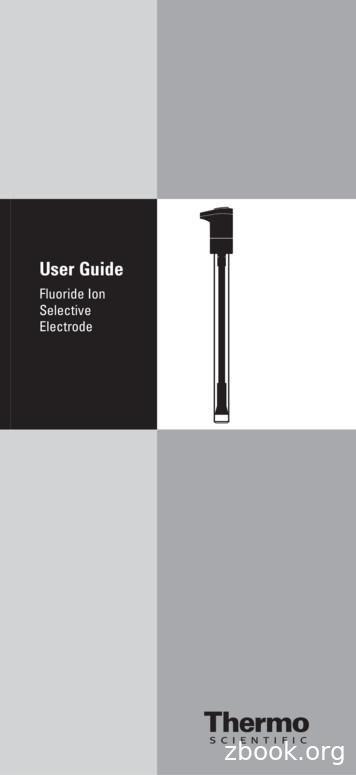BCDEdit Reference
BCDEdit ReferenceJune 13, 2007AbstractIn Windows Vista and later versions, the boot configuration data (BCD) storecontains the boot configuration parameters and controls the computer‘s bootenvironment. BCDEdit is a Windows Vista command-line tool that can be used toadd, delete, edit, and modify data in a BCD store. This paper is a reference forBCDEdit commands, data types, and well-known identifiers.This information applies for the following operating systems:Windows Server 2008Windows VistaThe current version of this paper is maintained on the Web irmware/bcdeditref.mspxReferences and resources discussed here are listed at the end of this paper.ContentsIntroduction . 3Terminology . 4BCDEdit Commands . 5bootems . 6bootdebug . 6bootsequence. 7copy. 8create . 8createstore . 10dbgsettings . 10debug . 12default . 12delete . 12deletevalue . 13displayorder. 14ems . 15emssettings . 15enum . 16export . 17import . 17set . 18store . 19sysstore . 20timeout . 20toolsdisplayorder . 20v . 21BCDEdit Identifiers. 22BCDEdit Data Formats . 23BCDEdit Data Types . 23All Entry Types . 24Boot Applications . 25Windows Boot Manager . 26Windows Boot Loader . 26Memory Diagnostic Application . 28Resume Application . 28
BCDEdit Reference - 2Firmware Boot Manager . 28Ntldr. 29Boot Sector Application . 29Device Additional Options . 29Custom Data Types . 29Resources . 29DisclaimerThis is a preliminary document and may be changed substantially prior to final commercial release of thesoftware described herein.The information contained in this document represents the current view of Microsoft Corporation on theissues discussed as of the date of publication. Because Microsoft must respond to changing marketconditions, it should not be interpreted to be a commitment on the part of Microsoft, and Microsoft cannotguarantee the accuracy of any information presented after the date of publication.This White Paper is for informational purposes only. MICROSOFT MAKES NO WARRANTIES,EXPRESS, IMPLIED OR STATUTORY, AS TO THE INFORMATION IN THIS DOCUMENT.Complying with all applicable copyright laws is the responsibility of the user. Without limiting the rightsunder copyright, no part of this document may be reproduced, stored in or introduced into a retrievalsystem, or transmitted in any form or by any means (electronic, mechanical, photocopying, recording, orotherwise), or for any purpose, without the express written permission of Microsoft Corporation.Microsoft may have patents, patent applications, trademarks, copyrights, or other intellectual propertyrights covering subject matter in this document. Except as expressly provided in any written licenseagreement from Microsoft, the furnishing of this document does not give you any license to thesepatents, trademarks, copyrights, or other intellectual property.Unless otherwise noted, the example companies, organizations, products, domain names, e-mailaddresses, logos, people, places and events depicted herein are fictitious, and no association with anyreal company, organization, product, domain name, email address, logo, person, place or event isintended or should be inferred. 2006-2007 Microsoft Corporation. All rights reserved.Microsoft, MS-DOS, Windows, Windows Server, and Windows Vista are either registered trademarks ortrademarks of Microsoft Corporation in the United States and/or other countries.The names of actual companies and products mentioned herein may be the trademarks of theirrespective owners.June 13, 2007 2006-2007 Microsoft Corporation. All rights reserved.
BCDEdit Reference - 3IntroductionThe boot configuration data store (BCD) contains boot configuration parametersand controls how the operating system is booted for Windows Vista and laterversions. With earlier versions of Windows , the way in which boot configurationdata was handled depended on the system‘s firmware:For BIOS-based systems, boot configuration data was contained in a text filenamed Boot.ini.For Extensible Firmware Interface (EFI)–based systems, boot configurationdata was contained in nonvolatile RAM (NVRAM).BCD abstracts the underlying firmware and provides a common programminginterface that can be used to manipulate the boot environment for all systemsrunning Windows Vista or later versions of Windows. Every such system has asystem BCD store that contains the data that controls the boot environment.Systems can have additional BCD stores, but only one store at a time can bedesignated as the system store.Unlike Boot.ini, BCD stores data in a binary format and cannot be edited with a texteditor. Instead, Windows Vista provides several ways to access a computer‘s BCDstores:The Windows Vista user interface (UI)MSConfig and the Shell‘s Control Panel System application provide end userswith access to a limited subset of the data in the BCD system store, includingthe Windows Boot Manager‘s time-out setting, and the debug and safe-modesettings.BCDEditBCDEdit is a command-line editor—included with Windows Vista and laterversions—that provides complete access to all BCD stores on the system.BCDEdit can be used to create or delete BCD data stores, designate a newsystem store, and add, delete, or modify the data in an individual store.The BCD Windows Management Instrumentation (WMI) providerThis component exposes an API that provides management tools with completeaccess to all BCD stores on the system.This paper is a complete reference for the Windows Vista BCDEdit commands,identifiers, formats, and data types. For a quick reference while using BCDEdit, youcan run the /? help command.To display a list of commands, run:bcdedit.exe /?To display details for a particular command, run:bcdedit.exe /? commandFor example, to display information about the /createstore command, run:bcdedit.exe /? /createstoreTo display a list of well-known boot entry identifiers, run:bcdedit.exe /? idTo display a list of formats, run:bcdedit.exe /? formatsJune 13, 2007 2006-2007 Microsoft Corporation. All rights reserved.
BCDEdit Reference - 4For a general discussion of the BCD store and the Windows boot environment, see―Boot Configuration Data in Windows Vista‖ on the WHDC Web site. For moreinformation on the BCD WMI API, see ―BCD Reference‖ on MSDN.Note: You should run BCDEdit from a command window with elevated privileges.To do so:On the Start menu, click All Programs, Accessories, and then CommandPrompt.Right-click Command Prompt and click Run as administrator on the contextmenu.A User Account Control dialog box appears. Click Continue to run thecommand window with administrative privileges.TerminologyThe following list defines the key BCDEdit terms that are used in this paper.BCD storeA binary file that contains boot configuration data in Windows Vista and laterversions. Boot applications use the system BCD store—which is on the systempartition—during the boot process. You can also create additional BCD storesin separate files by using the /export command or by copying a BCD file.boot applicationA boot entry that represents a boot environment application, such as WindowsBoot Manager, the Windows boot loader, or the Windows resume-fromhibernate application.boot entryAn object in the BCD store. BCD stores can contain several types of bootentries, including the following boot applications:Boot Manager, which controls boot flow. In a dual-boot system, BootManager displays a boot selection menu to the user.The Windows boot loader, which loads a particular version or configurationof Windows Vista or later versions of Windows.Ntldr, which is the boot loader for versions of Windows earlier thanWindows Vista.The resume application, which restores Windows to its running state whena computer resumes from hibernation.The memory diagnostics application, which runs a set of memorydiagnostics.Boot entries can also be used for other purposes, such as the global RAMdefect list or the global boot loader settings.commandA BCDEdit command. Commands are arguments to BCDEdit that consist of a ‗/‘character followed by the command name. Most commands also have one ormore arguments that are listed following the command. To run a command,type:bcdedit /command [arguments.]boot loaderA loader that loads Windows Vista and later versions of Windows.June 13, 2007 2006-2007 Microsoft Corporation. All rights reserved.
BCDEdit Reference - 5data type/elementOne or more data values that each boot entry has. Because elements have twocharacteristics—a name and an associated data type, they are also referred toas data types. For example, Boot Manager has a Timeout element thatcontrols how long Boot Manager waits before automatically selecting the defaultboot entry.firmware boot managerOn EFI-based systems, the entry in NVRAM that the firmware uses to locateWindows Boot Manager.identifierAn associated globally unique identifier (GUID) that each boot entry has andthat BCDEdit uses as an identifier for the entry.memory diagnostic applicationA boot environment tool that runs memory diagnostic tests, often referred to asMemdiag.NtldrThe legacy Windows boot loader, which loads versions of Windows earlier thanWindows Vista.resume applicationA boot application that handles the resume-from-hibernation operation.system BCD storeThe BCD store that Windows Boot Manager uses to control boot flow.well-known identifiersIdentifiers for commonly used boot entries that serve as readable aliases for thefull GUIDs. For example, Boot Manager‘s well-known identifier is {bootmgr}.There are also virtual identifiers, where the associated GUID can vary from oneboot to the next. For example, {current} is the well-known identifier for thecurrently booted operating system. For a complete list of well-known identifiers,see ―BCDEdit Identifiers‖ later in this paper.Windows Boot ManagerA boot environment application that initiates the boot process. With a multibootsystem, Boot Manager displays an operating system selection menu. It usesthe BCD store to locate the Windows loader to continue loading a specificversion of Windows.BCDEdit CommandsThe following table summarizes the BCDEdit commands by category. The sectionsthat follow the table provide detailed references for each command, presented inalphabetical order.CommandDescriptionCommands that operate on a store/createstoreCreates a new empty BCD store./exportExports the contents of the system BCD store to a specified file./importRestores the state of the system BCD store from a specified file.Commands that operate on boot entries in a store/copyMakes copies of boot entries./createCreates new boot entries./deleteDeletes boot entries.June 13, 2007 2006-2007 Microsoft Corporation. All rights reserved.
BCDEdit Reference - 6CommandDescriptionCommands that operate on elements/deletevalueDeletes elements from a boot entry./setCreates or modifies a boot entry‘s elements.Commands that control output/enumLists the boot entries in a store.Commands that control Boot Manager/bootsequenceSpecifies a one-time boot sequence./defaultSpecifies the default boot entry./displayorderSpecifies the order in which Boot Manager displays its menu./timeoutSpecifies the Boot Manager Timeout value./toolsdisplayorderSpecifies the order in which Boot Manager displays the tools menu.Commands that control Emergency Management Services/bootemsEnables or disables Emergency Management Services (EMS) for aspecified boot application./emsEnables or disables EMS for an operating system boot entry./emssettingsSpecifies global EMS parameters.Commands that control debugging/bootdebugEnables or disables boot debugging for a boot application./dbgsettingsSpecifies global debugger parameters./debugEnables or disables kernel debugging for an operating system bootentry.Commands that modify other commands/storeSpecifies the BCD store upon which a command acts./vDisplays boot entry identifiers in full, rather than using well-knownidentifiers./bootemsEnables or disables EMS for a specified boot application:bcdedit [/store filename] /bootems [id] { ON OFF }Parameters/store filenameOptional. The BCD store to be used. The default value is the system store./store is discussed later in this paper.idOptional. The identifier of the boot application to be modified. The default valueis the current operating system entry.ON OFFRequired. ON enables EMS, and OFF disables EMS.ExampleThe following command enables EMS for Boot Manager:bcdedit /bootems {bootmgr} ONRemarksThis command runs without errors for any boot entry, but affects only bootapplications./bootdebugEnables or disables the boot debugger for a specified boot entry:bcdedit [/store filename] /bootdebug [id] { ON OFF }June 13, 2007 2006-2007 Microsoft Corporation. All rights reserved.
BCDEdit Reference - 7Parameters/store filenameOptional. The BCD store to be used. The default value is the system store./store is discussed later in this paper.idOptional. The identifier of the boot entry to be modified. The default value is thecurrent operating system entry.ON OFFRequired. ON enables boot debugging, and OFF disables boot debugging.ExamplesThe following command enables boot debugging for the Windows boot loaderfor the current operating system:bcdedit /bootdebug ONThe following command disables boot debugging for Boot Manager:bcdedit /bootdebug {bootmgr} OFFRemarksThis command runs without errors for any boot entry, but affects only bootapplications./bootsequenceSpecifies the boot entries and display order for a one-time boot sequence:bcdedit [/store filename] /bootsequence id [.] [ /addfirst /addlast /remove ]Parameters/store filenameOptional. The BCD store to be used. The default value is the system store./store is discussed later in this paper.id [.]Required. A list of identifiers for the entries to be added or removed. You mustspecify at least one entry. To specify multiple entries, list the identifiers on thecommand line in the order in which they should appear in the boot sequence,separated by a space./addfirst /addlast /removeOptional. You can specify one of the commands from this set. They apply toonly a single boot entry, so if you use them, the identifier list must contain onlyone value./addfirstAdds the specified boot entry to the beginning of the one-time boot sequence.If the boot entry is already in the sequence, it is moved to the beginning./addlastAdds the specified boot entry to the end of the one-time boot sequence. If theidentifier is already in the sequence, it is moved to the end./removeRemoves the specified boot entry from the one-time boot sequence. If theone-time boot sequence has only one entry, then the one-time boot sequencevalue is deleted from the Boot Manager entry. If the specified boot entry is notin the one-time boot sequence, the /bootsequence command has no effect.June 13, 2007 2006-2007 Microsoft Corporation. All rights reserved.
BCDEdit Reference - 8ExamplesThe following command specifies a one-time boot sequence with three entries.The first two are Windows boot loaders, identified by their GUIDS, followed bythe well-known identifier for Ntldr:bcdedit /bootsequence b8-4885-951a-fa03044f5d71} {ntldr}The following command adds a Windows boot loader entry, specified by itsGUID, to the end of the one-time boot sequence:bcdedit /bootsequence rksThis command creates a display order to be used only for the next boot. Bydefault, the boot sequence specified by the identifier list replaces the existingsequence. To modify an existing sequence, use the /addfirst /addlast /remove arguments.This command is similar to /displayorder, except that a one-time bootsequence is used only once: the next time the system is booted. After that hasoccurred, the system reverts to the regular display order./copyCreates a copy of a specified boot entry:bcdedit [/store filename] /copy id /d descriptionParameters/store filenameOptional. The BCD store to be used. The default value is the system store./store is discussed later in this paper.idRequired. The identifier of the boot entry to be copied./d descriptionRequired. A string that contains the description to be associated with the newboot entry.ExampleThe following command creates a copy of Windows boot loader entry in thesystem BCD store:bcdedit /copy {cbd971bf-b7b8-4885-951a-fa03044f5d71} /d "Copyof entry"RemarksThis command creates a new GUID for the copy. When the command returns,BCDEdit displays the new GUID in the command window./createCreates a new boot entry:bcdedit [/store filename] /create [id] /d description [/application apptype /inherit[apptype] /inherit DEVICE /device]June 13, 2007 2006-2007 Microsoft Corporation. All rights reserved.
BCDEdit Reference - 9Parameters/store filenameOptional. The BCD store to be used. The default value is the system store./store is discussed later in this paper.idOptional. The new boot entry identifier:If you set id to a well-known identifier, such as {ntldr}, you cannot use the/application, /inherit, and /device options.If you set id to a GUID that does not correspond to a well-known identifier,you must use /application, /inherit, or /device to specify the boot entrytype. BCEdit checks the GUID to ensure that it is not equal to the identifierof an existing entry.If you do not specify an identifier, BCDEdit creates a new GUID to serve asthe entry‘s identifier. You must use /application, /inherit, or /device tospecify the boot entry type./d descriptionRequired. A string that contains the new boot entry‘s description./application apptypeOptional. If id is not set to a well-known identifier, the option that is used tospecify the new boot entry as an application entry, with an application type ofapptype, which must be set to one of the values in the following e boot sector applicationThe Windows boot loaderA resume applicationYou cannot use the /application option for other types of applications. Instead,you must set id to the application‘s well-known identifier./inherit [apptype]Optional. If id is not set to a well-known identifier, the option that is used tospecify the new boot entry as an inherit entry that can be inherited by theapplication type specified by apptype. The application type can be one of thevalues in the following ROSLOADERRESUMEDescriptionBoot ManagerThe boot sector applicationThe firmware boot managerThe memory diagnostics applicationNtldrThe Windows boot loaderThe resume applicationIf you do not specify an apptype value, any boot entry can inherit the new bootentry./inherit DEVICEOptional. If id is not set to a well-known identifier, the option that is used tospecify the new boot entry as an inherit entry that only a device options bootentry can inherit./deviceOptional. If id is not set to a well-known identifier, the option that is used tospecify the new boot entry as an additional device options entry.June 13, 2007 2006-2007 Microsoft Corporation. All rights reserved.
BCDEdit Reference - 10ExamplesThe following command creates an Ntldr boot entry:bcdedit /create {ntldr} /d "Legacy OS Loader"The following command creates a RAM disk additional options boot entry:bcdedit /create {ramdiskoptions} /d "Ramdisk options"The following command creates a new Windows boot loader entry:bcdedit /create /d "Windows Vista" /application osloaderThe following command creates a new debugger settings boot entry:bcdedit /create {dbgsettings} /d "Debugger Settings"RemarksIf you set id set to a well-known identifier, such as {ntldr} or {dbgsettings}, youcannot use the /application, /inherit, and /device options. Those options arealready defined for well-known identifiers. If you set id to something other thana well-known identifier or if you do not specify an id value, you must specify theboot entry‘s inheritance characteristics by using one of the /application,/inherit, or /device options./createstoreCreates a new empty BCD store:bcdedit /createstore [filename]ParametersfilenameOptional. The file name of the new BCD store. If the file name contains spaces,it must be enclosed in quotation marks ("").If you do not specify a file name, BCDEdit creates a new empty systemBCD store.If you specify just the file name, BCDEdit creates the file in the currentdefault folder.To have the file placed in a specific folder, set filename to the fully qualifiedpath. You can use environment variables as part of the path. The path mustend in a valid file name, such as c:\temp\mystore. The command fails if thepath ends in the name of a folder, such as c:\temp, or the name of anexisting file.ExampleThe following command creates a BCD store named C:\Data\BCD:bcdedit /createstore C:\DATA\BCD/dbgsettingsSets or displays the global debugger settings:bcdedit [/store filename] /dbgsettings [debugtype [DEBUGPORT:port][BAUDRATE:baud] [CHANNEL:channel] [TARGETNAME:targetname] /start startpolicy/noemux]Parameters/store filenameOptional. The BCD store to be used. The default value is the system store./store is discussed later in this paper.June 13, 2007 2006-2007 Microsoft Corporation. All rights reserved.
BCDEdit Reference - 11debugtypeOptional. The type of debugger. debugtype can be set one of the following:SERIAL1394USBThere is no default debugging type. If you omit debugtype, /dbgsettingsdisplays the current settings.DEBUGPORT:portOptional. If debugtype is set to SERIAL, the option that is used to specify whichserial port to use as the debugging port. Set port to 1 for COM1, and so on.BAUDRATE:baudOptional. If debugtype is set to SERIAL, the option that is used to specify thebaud rate to be used for debugging. Set baud to 57600 for a baud rate of57,600, and so on. Valid baud rates are 9600, 19200, 38400, 57600, and115200, and the default value is 9600. If you assign any other value to baud,BCDEdit returns an ―Invalid baud rate‖ error.CHANNEL:channelOptional. If debugtype is set to 1394, the option that is used to specify the 1394channel to be used for debugging. Set channel to the appropriate 1394channel.TARGETNAME:targetnameOptional. If debugtype is set to USB, the option that is used specifies the USBtarget name to be used for debugging./start startpolicyOptional. The debugger start policy for all debugger types. startpolicy can beset to one of the following:ACTIVEAUTOENABLEDISABLEBy default, startpolicy is set to ACTIVE./noumexOptional. The option that causes the kernel debugger to ignore user-modeexceptions.ExamplesThe following command displays the current global debugger settings:bcdedit /dbgsettingsThe following command sets the global debugger settings to serial debuggingover COM1 at 115,200 baud:bcdedit /dbgsettings SERIAL DEBUGPORT:1 BAUDRATE:115200The following command sets the global debugger settings to 1394 debuggingon channel 23:bcdedit /dbgsettings 1394 CHANNEL:23The following command sets the global debugger settings to use USBdebugging with a target named DEBUGGING:bcdedit /dbgsettings USB TARGETNAME:DEBUGGINGTo set an individual global debugger setting, use the /set command, as follows:bcdedit /set {dbgsettings} debugtype valueJune 13, 2007 2006-2007 Microsoft Corporation. All rights reserved.
BCDEdit Reference - 12RemarksThe /debugsettings command does not enable or disable the debugger. Youmust use /debug for that purpose./debugEnables or disables the kernel debugger for a specified boot entry:bcdedit [/store filename] /debug [id] { ON OFF }Parameters/store filenameOptional. The BCD store to be used. The default value is the system store./store is discussed later in this paper.idOptional. The identifier of the boot entry for which kernel debugging is to beenabled or disabled. This value can be set only to Windows boot loader entries.By default, id is set to {current}.ON OFFRequired. ON enables kernel debugging, and OFF disables kernel debugging.ExamplesThe following command enables kernel debugging for the current Windowsboot loader entry:bcdedit /debug ONThe following command disables kernel debugging for the specified Windowsboot loader entry:bcdedit /debug {cbd971bf-b7b8-4885-951a-fa03044f5d71} OFF/defaultSpecifies the boot entry to be used by default if the user does not select an entrybefore the time out expires:bcdedit [/store filename] /default idParameters/store filenameOptional. The BCD store to be used. The default value is the system store./store is discussed later in this paper.idRequired. The default boot entry‘s identifier.ExamplesThe following command sets the specified Windows boot loader as the defaultBoot Manager entry:bcdedit /default {cbd971bf-b7b8-4885-951a-fa03044f5d71}The following command sets Ntldr as the default boot entry:bcdedit /default {ntldr}/deleteDeletes a boot entry from a BCD store:bcdedit [/store filename] /delete id [/f] [/cleanup /nocleanup]June 13, 2007 2006-2007 Microsoft Corporation. All rights reserved.
BCDEdit Reference - 13Parameters/store filenameOptional. The BCD store to be used. The default value is the system store./store is discussed later in this paper.idRequired. The identifier of the boot entry to be delete
The Windows boot loader, which loads a particular version or configuration of Windows Vista or later versions of Windows. Ntldr, which is the boot loader for versions of Windows earlier than Windows Vista. The resume application, which restores Windows to it
The Getting Started manual, the User’s Guide, and the Reference manuals cross-reference each other. [R] regress [D] reshape [XT] xtreg The first is a reference to the regressentry in the Base Reference Manual, the second is a reference to the reshapeentry in the Data Management Reference Manual, and the third is a reference to the
The VHDL Golden Reference Guide is a compact quick reference guide to the VHDL language, its syntax, semantics, synthesis and application to hardware design. The VHDL Golden Reference Guide is not intended as a replacement for the IEEE Standard VHDL Language Reference Manual. Unlike that document, the Golden Reference guide does not offer a
Inclusion of ADE, SADE, USADE and AMP at 4 Inclusion of ADE, SADE and USADE Reference to Laboratory file Addition of customer feedback at 5.3.4 & 6.5.6 Addition of Data Protection Act 1998 at 5.4.3 Reference to QMS Matrix at 6.1.2 Reference to environmental procedures at 6.1.4 Reference to Study Specific SOPs Reference to corrections within CAPA at 6.5.3 Reference to Biorepository and e .
Sep 16, 2008 · reference types are configured in the Reference Types preferences. These files update automatically to reflect changes made in the Reference Types preferences (such as changing the name of a field). If you have created a custom reference type, it while be necessary to add a template for that reference type into the
pose-robust face recognition remains a challenge. To meet this challenge, this chap-ter introduces reference-based similarity where the similarity between a face image and a set of reference individuals (the "reference set") defines the reference-based descriptor for a face image. Recognition is performed using the reference-based
a professional letter of reference. A professional reference is typically a current or former employer, colleague, client, vendor, supervisor or someone else who has first-hand knowledge and can recommend you for employment. Character Reference A character reference letter discusses the candidate's personality, character, and overall abilities .
900100 Single Junction Reference Electrode– Prepare the reference electrode according to the reference electrode user guide. Fill the reference electrode with single junction reference fi lling solution, Cat. No. 900001. 9609BNWP Fluoride Combination Electrode– Remove the protective shipping cap from the sensing element and save
A-Level Business Studies Question and Answers 2020/2021 All copyright and publishing rights are owned by S-cool. First created in 2000 and updated in 2013, 2015 & 2020. 2 Contents People in the Workplace (Questions) . 3 People in the Workplace (Answers) . 4 Budgeting, Costing and Investment (Questions). 6 Budgeting, Costing and Investment (Answers) . 7 Business Objectives and .























